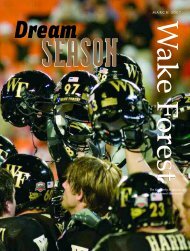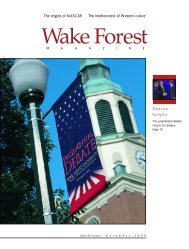Covers Contents - Past Issues - Wake Forest University
Covers Contents - Past Issues - Wake Forest University
Covers Contents - Past Issues - Wake Forest University
- No tags were found...
You also want an ePaper? Increase the reach of your titles
YUMPU automatically turns print PDFs into web optimized ePapers that Google loves.
A R O U N D T H E Q U A DThe clot thickensPhysics professor’s research reveals fibers stretch more than previously thought.THE RESEARCH FINDINGS ofAssistant Professor of PhysicsMartin Guthold made a splashthis summer when a paper onblood clots that he co-authoredwas published in the journalScience and followed up by storiesin newspapers around thecountry, including USA Today,the San Francisco Chronicle, andthe Houston Chronicle.Guthold’s findings—thatfibers that make up blood clotscan be stretched more than previouslythought—could haveprofound implications. It couldhelp medical researchers createmore accurate blood clot models,provide new insights into thewound healing process, and offera deeper understanding of heartattacks and strokes.Guthold, who joined the facultyin 2001, collaborated withcolleagues in the physics departmentand with researchers atthe School of Medicine and the<strong>University</strong> of North Carolina atChapel Hill. Senior Eric Sparksand graduate student WenhuaLiu, who work in Guthold’s lab,also contributed to the researchfindings.Roy Hantgan, an associateprofessor of biochemistry at themedical school and a member ofthe research team, said the studyfindings have significant implications.“Knowing that the fibrinstrands that make up a humanblood clot are more stretchablethan a spider’s web helps us tounderstand how clots can sealwounds tightly and withstandthe pressure in our blood vessels,”he explained. “This new informationalso helps us to understandhow tough it is to remove a clotthat is preventing blood flow to aperson’s heart or brain, causing aheart attack or stroke.”Blood clots are a three-dimensionalnetwork or mesh of fibrinfibers, stabilized by another proteincalled factor XIIIa. Becauseof its important function of stemmingthe flow of blood in thebody, clots have to be both strongand pliable. Fibrin fibers measureabout 100 nanometers in diameter,roughly 1,000 times smallerthan a human hair.The research conducted byGuthold and his team showedthat the tiny fibers have extraordinaryelasticity, on averagestretching to almost three timestheir length, while still retainingtheir ability to go back to theirnormal shape, and expanding tomore than four times their lengthbefore breaking. “For all naturallyoccurring fibers, fibrin fibers arethe ones you can stretch the furthestbefore they break,” Gutholdsaid. “This was a stunning revelationbecause people hypothesizedthat these fibers stretched butMartin Gutholdbroke much easier. In some cases,fibrin fibers had the ability to bestretched more than six timestheir length before they broke.”Scientists had previously beenunable to study the mechanicalproperties of individual fibrinfibers because of their small size.Guthold and his research teamcreated a device to do that bycombining two microscopes thatcould not only see the fibrinfibers but also stretch them. “Ourdiscovery of these mechanicalproperties of individual fibrinfibers shows that these fiberslikely endow blood clots withimportant physiological properties,”Guthold said. “They makeblood clots very elastic and verystretchable.”—Jacob McConnico,<strong>Wake</strong> <strong>Forest</strong> News Service6 WAKE FOREST MAGAZINE
















